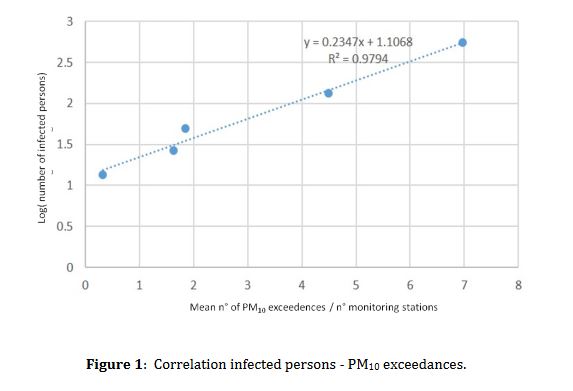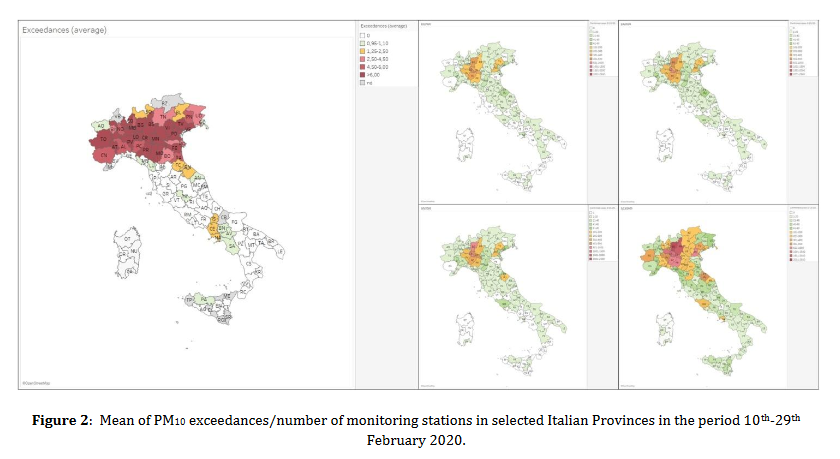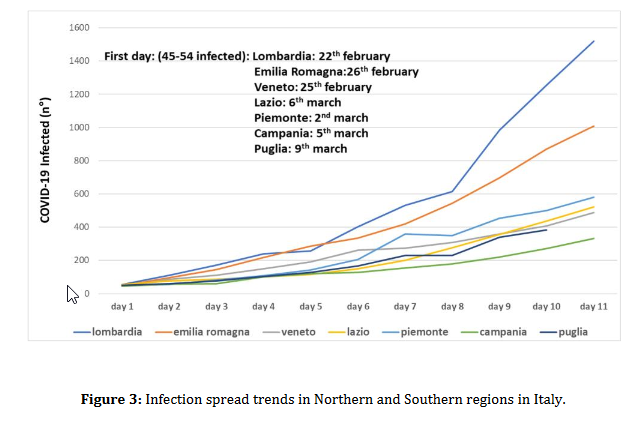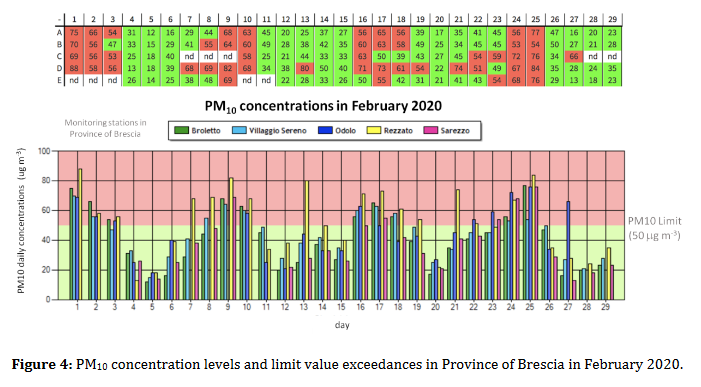Evaluation of the potential relationship between Particulate Matter (PM) pollution and COVID-19 infection spread in Italy

INTRODUCTION
To date, several scientificstudies focused on viruses diffusion among humans demonstrated that increased incidence of infection is related to airborne particulate matter (PM) concentration levels[1,2]. It is known that PM fractions (e.g., PM2.5 and PM10) serve as carrier for several chemical and biologic pollutants, viruses included. Viruses may be adsorbed through coagulation onto particulate matter composed by solid and/or liquid particles whose lifetime into the atmosphere is hours, days or weeks. Particles and adsorbed biologicpollutants may be subjected to diffusion into the atmosphere and transport, also at long distances (long-range transport). PM also represents a substrate allowing long term persistence of viruses into the atmosphere, hours or days. Viral inactivation depends on selected environmental parameters: if on the one hand both high temperature and solar radiation are able to speed up the inactivation rate, on the other hand high relative humidity may promote the diffusion rate [3]. Recently published scientific studies already highlighted the relationship between viruses diffusion among exposed population and particulate matterconcentration levels into the atmosphere.
According to Chen et al., 2010 ambient influenza and highly pathogenic avian influenza virus (H5N1)may besubjected to long-range transport due to saharian dust[4]. The authors demonstrated that the concentration of ambient influenza A virus was significantly higher during the Asian dust days than during the background days.Ye et al., in 2016 investigated whether Respiratory Syncytial Virus (RSV) infection in children in China was associated with ambient temperature and airbornepollutants [5]. RSVwas demonstrated to cause pneumonia in children and its penetration in the deepest parts of respiratory apparatus promoted by particle-based transport. A positive correlation between the infection rate and the particulate matter PM2.5 (r=0.446, P<0.001), PM10(r=0.397, P<0.001) was shown.
Chen et al., provided further evidence that virus incidence is associatedwith exposure to atmospheric high PM2.5 concentration levels in China[6]. More specifically, data on daily numbers of measles cases and PM2.5 concentrations were collected from21 cities in China during October 2013 and December2014.The authors highlightedthat 10 μg/m3increase in PM2.5 was significantly associated with increased measles incidence providing the final recommendation to apply PM abatement strategies in order to slow down the diffusion rate. Finally, the most recent study carried out by Peng et al., in 2020 demonstrated that PM concentration levels population was exposed to significantly affected the misleas spread in Lanzhou (China) [7].
As a result, the authors suggested to develop effective abatement strategies of PM concentration levels with the purpose to reduce potential risks for the population. Given the brief introduction reported above, it is possible to conclude that particulate matter fractions PM2.5 and PM10represent an effective carrier for viruses transport and diffusion and proliferationof virus diseases as well.
COVID-19 DIFFUSION IN ITALY: DIFFUSION RATE AND PM10 DAILY LIMIT VALUE EXCEEDANCES
With the purpose to assess the relationshipbetween PM concentration levels and COVID-19 diffusion rate,the following data were collected:-PM10daily concentration levels collected by environmental monitoring stations of Environmental Protection Agency (ARPA) network at National level. PM10 data by monitoring stations on Italian territory and publicly available on ARPA websites werecollected.The number of PM10daily limit value exceedances (50 μg/m3) and the number of environmental monitoring stations for each selected Province were both taken into account (number of PM10exceedances/number of stations for each Province). -number of COVID-19 infected persons for each selected Province reported on Civil Protection websiteand updated with daily frequency.Data matching allowed to highlight the association between thenumber of PM10daily limit value exceedances, registered in the period 10thFebruary-29thFebruary, andthe number of COVID-19 infected persons updated at 3th March.
The analysis of PM10 levels-infected caseswas carried out taking into account a delay time of 14 days, that is the estimated COVID-19 incubation period until symptoms manifestation and diagnosis. Correlation between the number of COVID-19 infected persons in each Province (reported on a logarithmic scale and classified in 5 different classes) and the average number of exceedances of PM10daily limit value for each class is reported in Figure 1 (R2=0,98). The average for each class was calculated dividing the average number of exceedancesby the number of monitoring station for each Province

This evidence leads the authors to the hypothesis of a direct relationship between the number of persons infected by COVID-19 and the PM10concentration levels in specificareas of Italian territory, confirming previous findings of recently published studies regarding environmental factors involved in viral infection spread. The hypothesis of a direct relationship between COVID-19 cases and PM10levels is strengthened by the evidence that concentration of COVID-19 outbreaks notified in Pianura Padanawas higher than in other parts of Italy (Figure 2).



